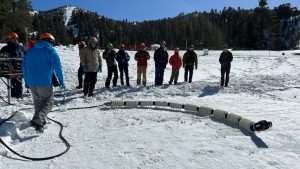NASA Jet Propulsion Laboratory

EELS Robot from NASA JPL
NASA’s Jet Propulsion Laboratory (JPL) is in the midst of a groundbreaking endeavor to create a versatile robot named EELS (Exobiology Extant Life Surveyor). This autonomous robot, reminiscent of a snake, is designed to navigate and explore environments previously unreachable by humans or existing technology. Its primary purpose is to search for signs of life, specifically targeting the icy crust of Saturn’s moon Enceladus. The EELS project, spearheaded by a team with a startup mentality, emphasizes rapid construction, frequent testing, and continuous learning and adjustment.
The innovative design of EELS allows it to traverse a diverse array of terrains, from undulating sand and ice to steep crater walls and complex glacier interiors. Matthew Robinson, the project manager at JPL, highlights the robot’s unique ability to adapt to various environments, a critical feature for missions in unknown or hazardous locations.
Conceived in 2019, EELS has undergone significant evolution. The current model, EELS 1.0, is a 13-foot-long assembly of 10 identical segments, each equipped with screw threads for movement and grip. This design enables the robot to efficiently move across different types of surfaces, ranging from soft terrain to icy conditions.
JPL’s approach to EELS’ development is unconventional, focusing on rapid prototyping and iterative testing. Hiro Ono, the principal investigator, compares the challenge to writing a new playbook for autonomous snake robot design, a field with no existing guidelines. The team’s philosophy is to embrace quick cycles of testing and refinement, diverging from traditional spacecraft development methods.
EELS’ autonomous capabilities are crucial for deep space missions, where communication delays make real-time human control impractical. Equipped with lidar and stereo cameras, the robot can independently map its environment and choose the safest path forward. This autonomy extends to its problem-solving abilities, allowing it to recover from unexpected challenges without human intervention.
In September 2022, a portion of EELS was tested in a vertical shaft on Athabasca Glacier in Alberta, simulating conditions similar to icy moons. The team plans to return for further tests, focusing on the robot’s subsurface mobility and its ability to deploy sensors for scientific research.
Looking ahead, the EELS team is exploring the integration of scientific instruments to enhance the robot’s utility for future exploratory missions. Funded by NASA’s Office of Technology Infusion and Strategy through the JPL Next program, EELS represents a pioneering effort in robotic exploration, potentially setting the stage for new discoveries in the most remote corners of our solar system and beyond.




